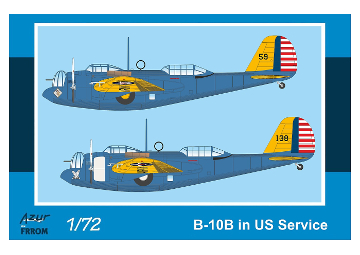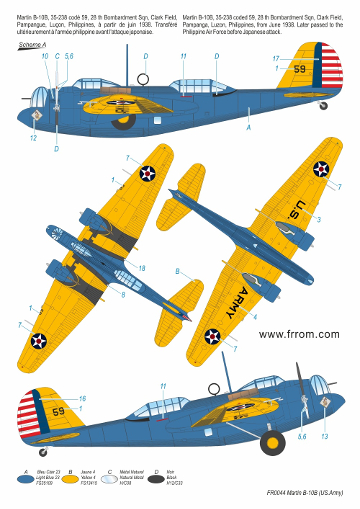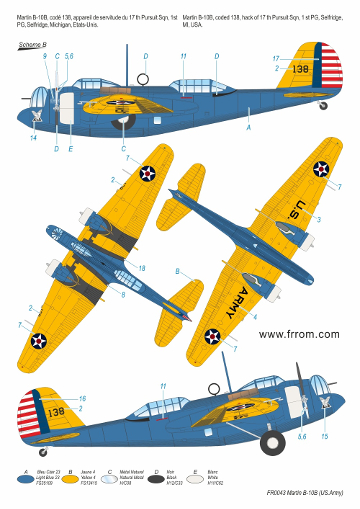FR0044 B-10B in US Service
History:
The prototype B-10 first flew on February 16, 1932, with delivery to the US Army Air Corps (USAAC) for testing on March 20. The B-10 combined several innovations including an all-metal airframe, fully cowled engines, retractable landing gear, enclosed gun-turret, and internal bomb-bay, which helped make it faster than fighters then in service and all other bombers obsolete. In doing so, it set the pattern that most subsequent bomber designs would emulate until the jet-age. Although built in relatively small numbers, the B-10 was revolutionary, and was the USAAC’s first all-metal monoplane bomber.

It defined the transition in eras from fabric-covered biplane to all-metal streamlined monoplane bombers defended by enclosed gun positions. In 1933, 14 pre-production YB-10s were ordered in January and delivered in November. The USAAC received 103 of the main production version, the B-10B, equipped with more powerful 675 hp Wright Cyclone R-1820-19 engines, and seven equipped with Pratt & Whitney Hornet engines which were designated B-12
The B-10 was cleared for export in July 1936 as the Model 139 with Wright engines and received designations reflecting the model (139), engine (W for Wright), country (first letter), and service user if applicable (A for army and N for navy). Customers included China (nine 139 WC), Argentina (22 139 WAA and 12 139 WAN), Turkey (20 139 WT), the Kingdom of Siam (six 139 WSM), and the Dutch East Indies which was the biggest user (13 139 WH-1, 26 139 WH-2, as well as 82 of an improved version, the Model 166 WH-3). One plane was also exported to the Soviet Union (139 WR) and another one to Japan (139 WJ). The latter country captured a few 139 WH-2 and WH-3 after the invasion of the Dutch East Indies, and passed these on to the Thai Air Force in 1944. The Kingdom of Siam used its 139 WSM against French Indo-China during the Franco-Thai war of January/February 1941
The USAAC employed the B-10B in its bombing and observation squadrons. In 1934, ten YB-10s under the command of Henry Arnold (later Chief of Staff of the USAF) flew a 13,340 km round-trip from the US capital, Washington DC, to Fairbanks in Alaska. These aircraft were painted with yellow wings and green fuselage, rather than blue, which was introduced in May 1934 for combat aircraft. B-10Bs were later re-finished in aluminium during overhauls according to new rules issued in September 1938, although some aircraft were still to be seen in the blue and yellow scheme for some time after this date. Skis and floats were also tested on the B-10B. The rapid evolution of bomber design in the 1930s led to the rather quick transfer of B-10s to the Air National Guard (ANG) and training units, allowing pilots to become familiar with a modern aircraft.
B-10Bs served with (among others) 10th OS in Panama, 1st OS at Mitchel Field, 11th BS, 20th BS, NASM, and ANG in different states. Three aircraft were transferred to the Philippine Army Air Force. A few remained in the US inventory (including two B-12 target tugs in Hawaii) when the Japanese attacked the USA in December 1941, and at least one B-10B was destroyed in the Philippines.
Specifications (B-10B): twin-engined monoplane bomber with retractable landing gear, metal construction, 3 crew members. Engines: two Wright Cyclone R-1820-19 of 675 hp. Wingspan 21.49 m, length 13.63 m, wing area 63 m2. Maximum altitude 5,182 m. Offensive armament: 1,029 kg of bombs, defensive armament 3 machine guns.
- Batailles Aériennes n°42 and 43 (on ML-KNIL, in french)
- Avions n°3, 4, 5 with informations on Model 139 WC in China, in french.
- Photos in the web.
- Martin 139W en Argentina, Jorge F. Nunez Padin, Fernando C. Benedetto (Spanish)
- Martin 139 WAN, Jorge F. Nunez Padin, (Museo de la Aviacion Naval - Instituto Aeronaval), Spanish
- Informations and photos generously transmitted by Mark Tutton, Starfighter Decals, on B-10B in Philippines (and elsewhere), by Michel Ledet on WH-x in service with ML-KNIL, by Patrick Laureau on Model 139 WC in China, we want to thank them very much for their help !
Camouflages :
- Cam A : B-10B, 35-238 coded 59, 28 th Bombardment Sqn, Clark Field, Pampanga, Luzon, Philippines, from June 1938. Written off inventory on 17 October, 1941, so not later passed to the Philippine Air Force, as written by mistake in the building notice.
- Cam B : B-10B, coded 138, hack of 17 th Pursuit Sqn, 1 st PG, Selfridge, MI, USA.

